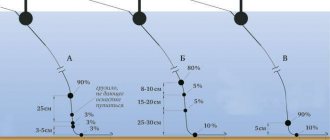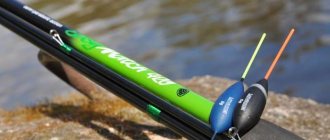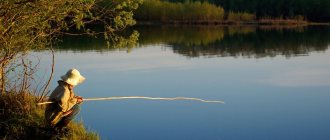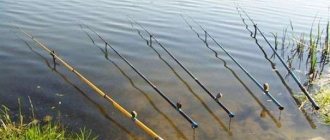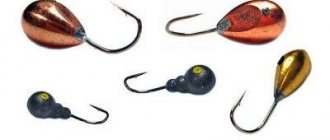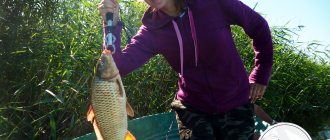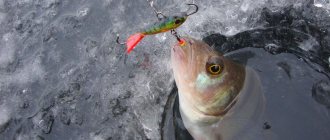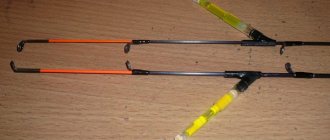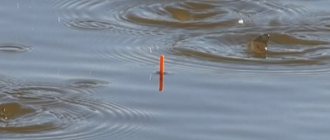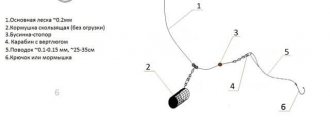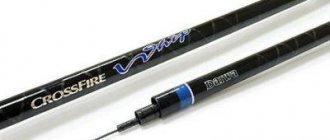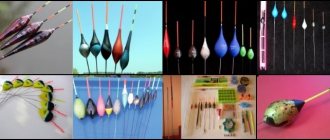Fishing on the current
Fishermen are usually divided into those who like to fish in still water and those who prefer fishing in currents and rivers.
Each of them can give a bunch of arguments about the merits of this and that fishing, but to each his own, it is simply believed that fishing in the current is more active, requiring more effort from the angler. Fans of fishing begin the summer season, practically, when the ice melts and the water warms up a little, so that the fish begin to actively feed and continue until there is no ice. In summer, on warm days, it is much more comfortable to fish than in autumn. When the leaves fly away, the shores are exposed, and the water becomes clear. Through the thickness of the water, you can see the bottom and what is happening there.
But the fish also sees the person on the shore well and becomes more careful. At this time it becomes more difficult to catch. In clear water, it is easier for fish to detect predators; pike and perch become hungry, and they will react faster to a spoon or wobbler, or a fisherman with a spinning rod. But at such times it is necessary to camouflage, to be able to work with light tackle, in places limited by bushes and trees, the ability to navigate the tackle among algae, snags and stones, while guiding in the current, is required.
Feeder equipment on the current
Many people believe that feeder equipment on the current is not of fundamental importance. Actually this is not true. For an insufficiently experienced fisherman, equipment can indeed create many problems . But in general, if you choose it correctly, it will be quite convenient.
The feeder should not be too heavy, otherwise the fish will not be able to move the weight. On the other hand, a feeder that is too light will not be able to stay on the bottom. But this contradicts the very essence of such a fishing method as a feeder. In addition to the feeder itself, the weight of the equipment is affected by the weight of all additional elements; this must be taken into account when choosing such equipment.
Equipment for fishing with a feeder is also a feeder reel. Fishing with this method often leads to re-casting of the equipment. Because of this, time is wasted on reeling, the fish calmly swims past, and therefore experts recommend using a reel with a high gear ratio. The value of this indicator should be equal to 6. This also requires the presence of a spool of the appropriate diameter. Thanks to this device, the line twists less, and ultimately this allows you to achieve the required casting distance.
Please note that the spool should not be deep, since feeder fishing requires a thin line. In addition, such equipment requires a stopper to secure the fishing line over long casting distances. If a fisherman is just mastering the feeder, this will be especially important for him.
Catching fish in the current requires not only casting range, but also casting accuracy. If you cast the feeder correctly, then gradually the small space at the bottom of the reservoir will be saturated with food, and the fish will swim here on their own.
Feeder rigs for currents are also hooks. They are equipped with a ring and a spatula. It is very important to keep them sharp. An important role is played by fastening the hook - certainly with a fisherman's knot.
Tackle for fishing on the current
For fishing in clear water, you should have a lightweight folding rod so that you can quickly change the place of fishing, because if you manage to pull one fish out of the school, then the school quickly leaves and does not return to its original place for a long time, having seen what happened to its fellow fish. In one place you will simply waste time and be left without a catch.
You also need a reel with a supply of fishing line of thirty meters to throw the bait with a hook upstream and lower the fishing line to the school. In this case, you can catch several pieces from one school of fish. Depending on the size of the fish, the line can vary between 0.15-0.20, the leash 0.1. A set of floats is required, light and dark in color, it all depends on the lighting, adjusted for the most careful bite, so that the very tip of the float is visible. A set of hooks from No. 3 to No. 5, with different long shanks, for attaching different baits.
Installing the feeder vertically
Along with the use of feeder equipment, the problem of equipment drift arises due to the large area of resistance to water flow. When watching fishermen, you can notice the high rise of the donkey and feeders on the fast river. When raising the gear, they lower the water level, preventing the line from drifting in the water. Another advantage of the approach is the ability to hook fish in a timely manner.
A feeder is a tackle for bottom fishing that can be used from the shore from a boat, in still water and in the current.
Looking up at the tip of the rod is quite uncomfortable. The best way to immerse the feeder vertically and not hold it is to fish from cliffs. The rod is placed on the edge of the cliff and secured with a small stand. The effect is similar to holding a leash with hooks in the water by hand. If the current is the result of the wind, even if the strength of the air current changes, we continue to keep the rod raised up, at any moment the next gust will come and carry away the tackle.
Lure
Bait is used occasionally, because you have to move periodically along the shore. You can throw in some maggots, oatmeal or bloodworms. As bait, it would be practical to use maggots; they stay on the hook better and longer; bloodworms can be attacked by small things.
Oatmeal is used as whole grains or as a dough with the addition of bread, mixing them to the desired consistency. It is unknown what kind of bait the fish will like today, so it’s worth taking different ones. Maggot can be prepared in advance and can be stored for up to two months in a regular refrigerator.
Fishing technique
Where it is shallow and the current is fast, there are most likely no fish, it stays at a depth of one and a half meters, with an average current, where the stream of water enters the pool and near the bushes, in this place the water slowly swirls. You can try to use a method where the pellet of the sinker is moved to the float itself and then the hook stretches along the bottom, the fish takes the bait more boldly.
When moving along the shore, carefully watch the water; on sunny days, roach and dace sometimes rise to the top and reveal themselves. You shouldn’t expect a good bite after long autumn rains, the river level changes, the water becomes cloudy, so it’s better to catch fish in long-term constant weather.
Bottom tackle for fishing on currents: what is it and how to make it yourself
Donka refers to simple ways of catching fish that live in the bottom layers of water. The simplest types of bottom gear have been used by people for a long time, during which time it was possible to find the best options for fishing in currents and still water. Bottom tackle for fishing in currents from the shore helps to catch large species of fish: bream, carp, carp, crucian carp, etc. Classic equipment with intense water flow turns out to be ineffective, but improved modifications can bring a good catch of large fish.
Equipment and installation of feeder for flow
To fish areas of a reservoir with a strong current, you will need a heavy feeder. It is best to give preference to models with carbon fiber tips that can withstand the casting of massive equipment.
The length of the rod for an extra-heavy class feeder should reach 3.9 – 4.2 meters, and the test weight should exceed 120 grams. The best gear for fishing in currents is:
- Zemex RIVER Super Feeder;
- Golden Catch Onnex River Feeder;
- Kalipso Titan Feeder;
- Rampage River Feeder.
When choosing a reel, you should give preference to designs with a baitrunner. The spool size should be between 3000-5000. The best reels in this category are:
- Fanatik Riga 5000;
- Salmo Elite Baitfeeder;
- GOSS KD.
The mass of the sinker is selected depending on the strength of the current. The recommended leash length is in the range of 15-90 cm. Most often, fishermen make leashes 40 cm long.
Feeder installation
- The knees of the tackle are joined so that the rings are located on the same line.
- The reel is secured to the rod using a screw/snap mechanism.
- The braid/line is passed through the rings and secured to the reel. The cord is wound and secured with a simple knot, leaving a small side (2 mm).
- After this, the feeder equipment and feeder are tied. Additionally, a titanium/tungsten leash equipped with a carabiner is attached.
The tackle is ready for use.
When choosing an equipment option, you should give preference to one of the following options:
- paternoster on the current;
- symmetrical loop;
- asymmetrical loop.
Paternoster with a feeder for using a feeder on the current.
Ease of installation and low risk of tangling the leash are considered the main advantages of the paternoster. Such equipment is actively used for fishing in rivers with strong currents and in standing reservoirs. Leashes should not be too short. The recommended leash length is 40-70 cm.
Symmetrical and asymmetrical loops are also often used by feeders when fishing in the current. This type of equipment is characterized by increased sensitivity.
Feeder feeders for currents, what is “vampire” and “duplex” - video review of reels for fast rivers:
Features of bottom gear for fishing in currents
The standard version of the equipment uses bottoms with elastic bands (optional), sliding weights or with a fixed position. All of the above models are applicable in small currents or in completely still water. When the water moves quickly, catching fish with bottom tackle becomes very difficult.
The main difficulties of using the classic version are that strong currents are often observed in large rivers and are located far from the shore, where the depth to the bottom is quite large, sometimes reaching 20-50 m. As the casting distance increases, the windage of the tackle increases, making an accurate cast is extremely difficult, and the current itself will begin to carry away the tackle, often causing snags in the debris.
We put a stiffer top
Rods are sold with a set of tips of varying degrees of rigidity. Usually there are from 3 to 5 vertices in a set. In strong winds or river currents, it is better to use rigid nozzles. There is a regularity - the higher the speed of water movement, the stiffer the top should be. The soft ends bend strongly in difficult conditions and are uncomfortable to look at. Even the hard tops bend a little, but they are much easier to use as a bite alarm.
It is easy to determine the rigidity of an element by looking at the marker on the body - as the index increases, the material becomes stiffer. If there are no markers, you will have to check the strength manually.
Many anglers ignore installing rigid gear because they think that the sensitivity of the feeder will decrease and the risk of missing a bite will increase. In reality, all tips, even the hardest ones, are quite sensitive and capable of transmitting bites from minnows or small roaches. The fish in the current takes the hook more confidently and sharply, there is no risk of missing a bite. If the angler uses a lot of gear, you can install bells.
Read more
How to catch carp on a feeder?
The tip of the feeder rod should be moderately rigid and, at the same time, moderately flexible
Carousel rig device
“Carousel” is the simplest fishing tackle that can be easily created from ordinary materials: fishing line, sinker, hooks and other elements. All necessary materials are sold in any fishing shops, their price does not hit the fisherman’s pocket.
“Carousel” is a bottom tackle for fishing in the current from a boat or from the shore, which does not require the use of a rod.
What it consists of:
- reel. It is used for storing equipment; 2 pieces of fishing line are wound on it. Transportation gear is installed in one area, it is also used for catching fish and changing bait, and the second is for attaching a leash with hooks;
- sinker. It is important to choose the right shape of the load; it must be in a stationary position at the bottom. Even in strong currents, the sinker should fit snugly to the bottom surface. To prevent rolling, it is better to use a flat weight; if it is of sufficient weight, the fisherman will be able to pull the fishing line and remove part of the equipment when changing bait, etc. Experienced fishermen distinguish the weight on their own, more often they make it in the shape of a cone, and in the center there is a throughput ring. The weight is selected taking into account the current; models of 250-500 g are more often used;
- leashes. The length of the leash is taken up to 1 m, but it is better to use 50-70 cm. On the day of manufacture, monofilament is used, but for large predators it is better to use fluorocarbon thread;
- baited hooks. They are selected individually depending on the species of fish being hunted. To reduce idle fish bites, the hook size is set according to the volume of the predator’s mouth, behavior and bait. Doubles and tees can be used on large aggressive predators.
It is important to make the guide ring as smooth as possible, otherwise the tackle will break on the burr.
A monofilament line with a cross-section of 0.4-0.6 mm is used as a transport thread, and the length is taken 2 times greater than the distance to the promising casting location, plus another 2-3 m for reserve. It is better to take the main line 0.25-0.35 mm.
If you plan to fish from the shore, 2 pegs are first prepared, and a fishing line is attached to them for transportation and fishing. It is important to stick them strictly vertically and check the strength of the fastening, otherwise the peg will break out under pressure or the thread will come off. Both improvised pegs in the form of tree branches and aluminum or stainless steel rods are suitable.
It has a design that allows you to avoid constant recasting
To detect a bite, it is better to use bite alarms for bottom gear (electronic or bell), but in their absence, you will have to hold the main fishing line in your hand and react to changes in its tension. Manually it is possible to detect even small bites, which helps to make accurate and timely hooks. Alarms are convenient in cases where several gears are used or you have to be away periodically.
Float fishing in strong currents
“Feeder place” on the channel named after.
Moscow. Photo: Andrey Yanshevsky. Practice suggests that the stronger the current in the river, the more active the fish.
As a rule, anglers choose donks as gear for fishing on the current - casters, feeders and pickers. Don’t forget about such a simple, but at times very effective method of fishing as the “half-bottom”.
However, if the fish is close to the shore, then the most effective tackle is a float. First of all, the plug and fly rod.
The advantages of a plug when fishing in the current are constantly talked about by many competent authors, so you just need to focus on the most important aspects.
First you need to assemble a plug, design equipment for a given depth and current strength, and equip at least one “spare kit” in case of changes in the current and fish activity.
Next is preparing the fishing spot, and this is very important to make fishing convenient. The variety of fishing techniques largely depends on how convenient it is to catch.
When choosing a place, it makes sense to use a depth gauge to measure not only several places, but also the relief in the selected place. When the fishing location has been determined, it is worthwhile to start baiting, since most complex baits swell within half an hour or more.
After this, using a depth gauge, a descent is installed on the hook and the location of the float is marked on the rod with a marker. This is done so that if the water level changes, the strength of the current, the activity of the fish changes, or after changing the equipment, it is possible not only to change the descent, but also to return or restore the original version.
It is often necessary to change the working descent when, for example, the roach bites first, and later the bream approaches, or when the fishing line is changed to constantly holding it above the fishing point.
Holding the rig above the fishing point in strong current conditions is a specific technique that “scares” many anglers. The fact is that the difficulty is not in technology, but in patience and experience in selecting equipment and working trigger.
It's actually quite simple. After baiting, you rig with a flat float. It is worth emphasizing that it is often necessary to use floats with a very decent carrying capacity, comparable to the carrying capacity of floats for long-distance casting.
Every few minutes, add a descent on the rig until the first bite, and then begin to select the optimal descent. The optimal descent can exceed the depth at the fishing point by one and a half or even two times, which is easily explained by the effect of the current on the fishing line.
Moreover, often, if the fishing depth is shallow and the fish are cautious, holding a rig with a flat float on a plug rod can transform into half-bottom fishing. Of course, in this case the float will not be in the air, but will have the most sensitive “water” position.
The interesting thing about the plug is that it is technically multi-variant. You can give the bait any movement.
With a fly rod it is somewhat more difficult, you need to work, so some anglers refuse to fish with a fly rod in strong currents, preferring to change the float to a bottom rig.
By making this choice, the angler can avoid fish closer to shore.
The main difficulty in swing fishing is that the rig is quickly carried by the current past the fish site, past the bait lying on the bottom.
The classic fishing technique, when the equipment simply floats and is held at the end of the swim, rarely allows you to catch large fish.
| The fish is not large, but actively resists the current. Photo: Andrey Yanshevsky. |
Firstly, you need bait that will lie on the bottom and gradually erode. You can make thick bait and wall up small pebbles in balls, but the easiest way is to take a net with bricks and rope and make a stationary feeder. Fill the feeder with bait and throw it into the water. It’s even better to lower it from above to the desired point from the boat.
After this, you can immediately start fishing. It may happen that after some time, each free swim will end with a bite of roach, silver bream or small bream. It makes sense to increase the descent in order to put the main sinker in the shape of a sliding olive on the bottom and replace the maggot with a worm, that is, use a larger bait. You will get a very easy version of the “running donkey”.
If the bottom is without a shell and there are not many hooks, then it makes sense to increase the length of the leash to a meter and periodically hold the rod as it swims through the rig.
If the fish bites only at a specific point and the current is as strong as a mountain stream, you can anchor the equipment. To do this, we take a sliding olive weighing twice as much as the carrying capacity of the float and remove the underwater. Next, you need to gradually increase the descent until the current completely floods the float.
It’s a kind of donka with a float, but it helped me a lot several times when catching large ides.
This is the case when, when fishing with a pole in the current, the length of the descent increases so that the bait reaches the bottom layer, and here, an increase in the descent is necessary so that the float is visible.
Long-cast fishing, the Bolognese method, to be honest, is more suitable for fishing in medium and gentle currents. The exception is fishing from the surface and half-water, as well as cases when you find yourself on the autumn run, for example, large silver bream.
September 1, 2021 at 05:00
Learning to fish with fast flowing water in a pond
Every fisherman has a dream to be able to catch a big fish. And if he still has to fight before he can get her ashore, then this is an indescribable pleasure.
The fish looks for where it is deeper, and the fisherman... where the fish are. Such a simple modification of the proverb implies rather ingenious “exercises” with equipment, a boat, bait and types of fishing rods, in order to eventually become the owner of a good fishing trophy. But fishing in a fast current is a sophisticated matter, taking into account a lot of objective factors, covering not only gear, but also the depth of the reservoir, the type of current and much more.
There are a number of erroneous axioms in fishing: that in the autumn, fish leave shallow waters and go to depth, that when pressure decreases, fish are pressed to the bottom, and if it increases, they rise to mid-water or to the surface. One of these erroneous axioms is that fish do not really like fast currents. Of course, “fast” is a relative concept. For example: in places where a half-ounce “castmaster” thrown down a fast current does not sink at all, but jumps like a “pancake” through the water, not only grayling and brown trout, but also pike and perch are excellently caught.
Character of the current
Content
The flow in the river is heterogeneous: in some places the water accelerates (mainly at turns and in places of narrowing), and in others it slows down. In areas with a turn and a significant expansion of the channel, reaches with a weak current are formed.
The speed of water flow also varies on a homogeneous segment, some areas with a faster current, others with a weaker current. It is not advisable to fish with a feeder at maximum current, directly in the riverbed. Most fish go to quieter places.
The places for catching ide and bream are located near the riverbed or in places where the bottom rises. The listed areas have lower water speed. The feeder on the small river is suitable for catching crucian carp; it is found nearby with reeds, grass, and also in depressions at the bottom. It is unlikely that you will be able to find crucian carp in stormy water; it tends to choose secluded areas.
Many fishermen believe that fishing with a feeder in the current is futile
If you plan to fish from a boat on the river, it is recommended to anchor close to the riverbed. Fish smell bait better in calm water. The same chub is found in rapids, but you won’t be able to catch it using feeders. For chub, it is effective to use a sliding weight with a large volume for a stable position on the bottom.
Lures for fishing in fast currents
Minnow wobblers, designed for jerking, function in any way. It is simply easier to find effective wiring for some, while for others it is more difficult.
Both grayling and brown trout are usually caught on cranks, but choosing a model is more difficult. Not everyone “keeps the flow”. If you need to choose a wobbler based on its appearance, choose a simpler one, without any oddities or frills. It is dangerous when the shoulder blade is narrow and long. Rotating spoons are used only homemade ones with a “willow leaf” petal configuration.
On powerful rivers, sometimes you need a long cast, it is very good to use jigs (flat cuts of a brass rod are used).
Typical situation
I drive up to the river and try to make a fishing plan. There are many good places, although there are no outstanding ones; you can go both downstream and upstream, and fish in both directions. In such a situation, you should allow yourself to move energetically and catch only the most energetic fish. Experts say that if the sun shines in the fish’s eyes, the bite is bad. Therefore, if you don’t jump, don’t stomp, and don’t wave your arms too much, and also make sure that the shadow doesn’t fall on the fishing spot, then a lot of bites happen almost under your feet. Still, if it is possible to avoid such illumination, it would be a good idea to do so. The river often meanders, and the sun has time to travel a long way across the sky during fishing, so there is often room for maneuver.
Casting distance
It’s difficult to describe the nuances of wiring, there are thousands of them, the water itself will tell you. I still can’t help but notice two points. Firstly, an extremely effective technique, especially for grayling, is keeping the bait at one point. Secondly, when choosing bait for fishing a certain place, you need to think about how to “snatch” it from the water: it happens that even a castmaster can strain the tackle to the limit.
Good fishing spots
The drain is a section of the river just above a powerful riffle or threshold, where the channel narrows and the depth decreases, the flow is forced, and the surface of the water is smooth almost everywhere (except for occasional disturbances from hefty stones). The drain is the most fruitful place. Here the most significant concentration is of active fish. The choice of bait and the method of placing it is dictated by the water.
Through the riverbed
At points where the water rushes past you in a brisk stream, and behind large boulders there are not calm spots, but bubbling “barrels,” you should only fish close to the banks. The weakened, uneven fast current creates a lot of tempting places, it would seem - catch fish and rejoice! However, the bite is bad. The situation changes greatly when you manage to cross the riverbed and fish near the opposite bank. The trout grab the bait burrowing into the stream better. I fish exclusively with oscillating spoons, I try to cast upstream, otherwise it’s difficult to drag the bait (especially the fish) across the riverbed.
Behind the big "suitcase"
Brown trout will be able to stand near any stone. And grayling clearly chooses the largest stones, behind which a wide, at least 4-7 m long, zone of moderate current is formed. A beginner will not pass by such points; there is nothing special to describe here. The best bait is a spinning spoon.
In the "seething"
Few fishermen fish in such places, so they are unusually good in crowded bodies of water and their areas. Here we are talking about small riffles with rapidly flowing currents.
Shallow ones - due to the fact that in deep ones it can easily be washed away. It is impossible to stand without leaning on a stick. Therefore, fishing is done from underwater rocks. Therefore, there can be no talk of meaningful retrieving; the rotating spoon is held in place for some time, then released 5–6 meters and held again. It usually bites quite well, but the fish are not large. Yes, you won’t be able to extract much...
"Jacuzzi" under the threshold
Such places, perhaps, are more reminiscent not of a jacuzzi, but of a bathtub, into which a strong stream flows from the tap. They look very attractive, but the fish in them are cautious - perhaps precisely thanks to the fishermen who never let out the pits. This is where a light shaker comes in handy!
There is another method of fishing in fast currents - feeder fishing.
Using a feeder in strong currents
Feeder fishing is entertaining in itself, although it can only reveal its full potential in fast currents. The flow of water, which often prevents the fisherman from keeping the feeder in one place, also does a huge service for the fisherman - it disperses the bait downstream. This makes it possible to lure fish to the equipment from a huge area of water. Although fishing in such conditions with a feeder is not easy, and in some areas it is even impossible.
The flow of the river in its various sections can differ significantly. Conventionally, it should be divided into medium - feeders weighing up to 70 - 75 grams are used, and strong - feeders heavier than 75 grams are used. In the first episode, there are no problems with proper feeding, the feeder stays well on the bottom, and the bait can be thrown almost to one point. In an intense current, everything is much more difficult, and sometimes it can be very difficult to hold the feeder, even using all the familiar methods.
Although even with a fast flow, you can find sections of the river where the water flow will be weaker. Places with reverse flows, whirlpools, bends in the riverbed, bays - you can almost always find them along the river. And such places can even be extremely catchy, because a huge number of fish also do not like intense currents, in which it is difficult to search for food and it is necessary to constantly expend effort to resist the fast current. But it is not always possible to search for such places, and there are situations when it is necessary to fish in an intense current. The main issue is the difficulty in establishing the bottom topography, as well as the demolition of the feeder. The fisherman casts to one point, and the feeder, adhering to the current, is sewn to the shore, and the bait is scattered along the entire path of its demolition.
Ways to solve the problem of strong current
If a promising site is located in a place with a fast river current, additional tricks are used to minimize the negative impact of water speed.
Basic rules for fishing on currents:
- install a feeder with a weight of 100 g or more so that it is less likely to be carried away;
- use stronger fishing line;
- the feeder on a fast river is installed at a right or close angle;
- select the correct shape of the feeder;
- a relatively rigid Quitertype is used;
- use heavy types of bait;
- the fishing line or cord is released a little to create a loop on the surface.
Fishing with a feeder on a fast-flowing river shows the best results when combining several techniques. Many methods are used exclusively in conjunction with others (the use of heavy types of food helps only when using a heavy or specific form of feeder).
Read more
How to choose the right feeder rod?
When using a boat, the feeder rod does not have to be long, especially since we are not talking about long casting
